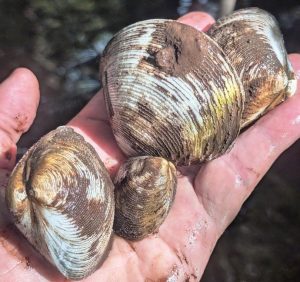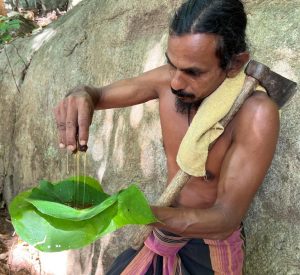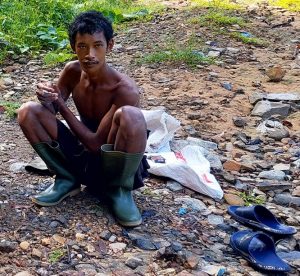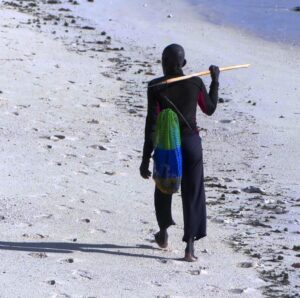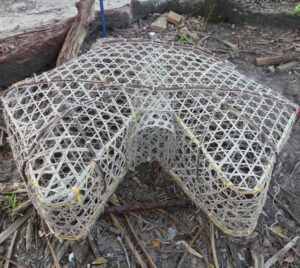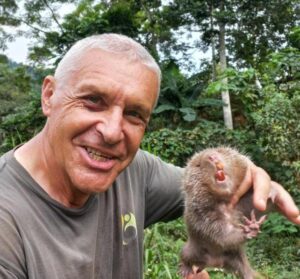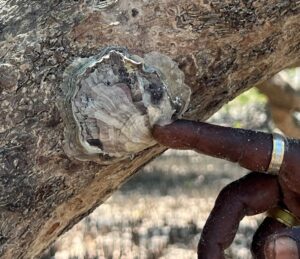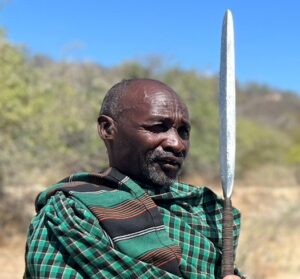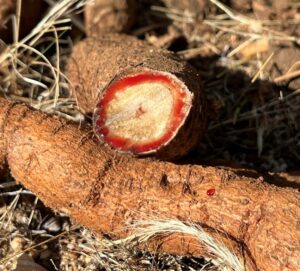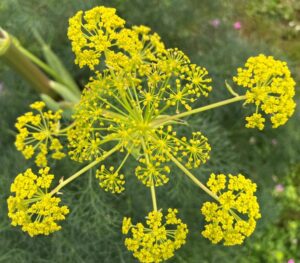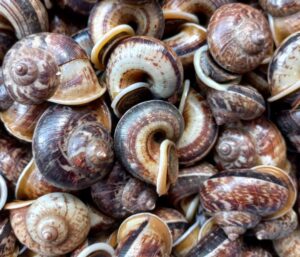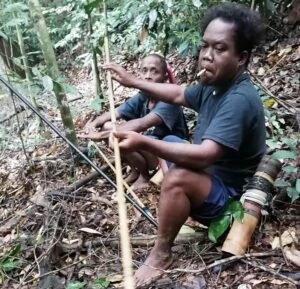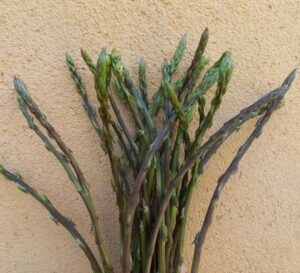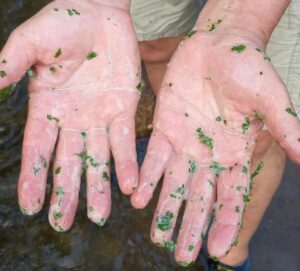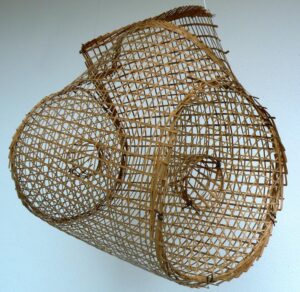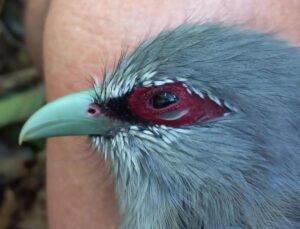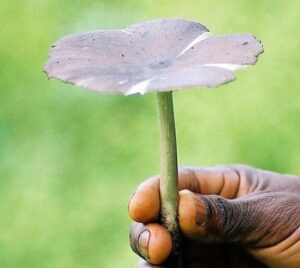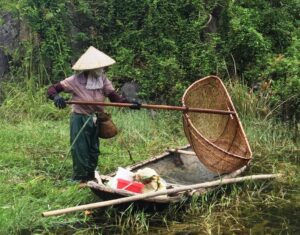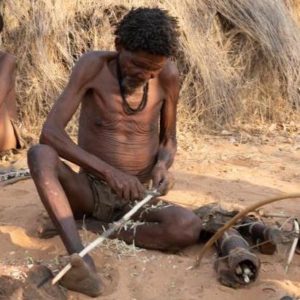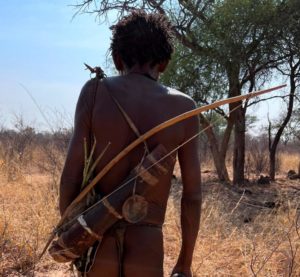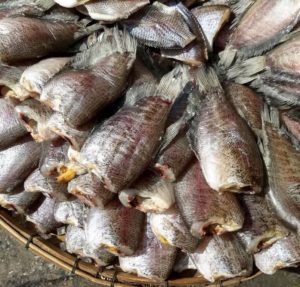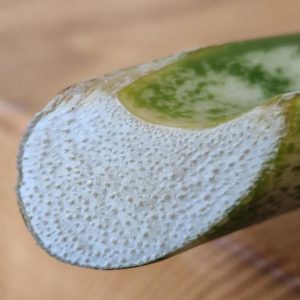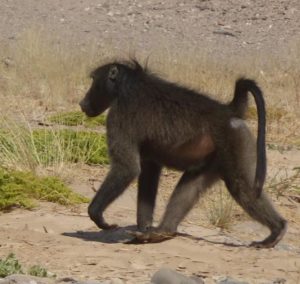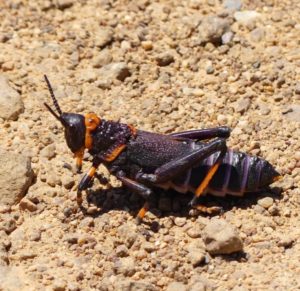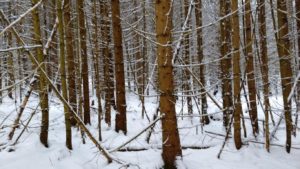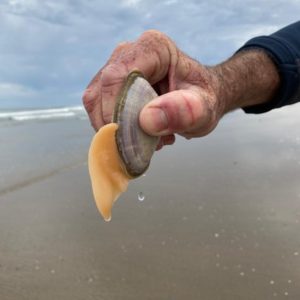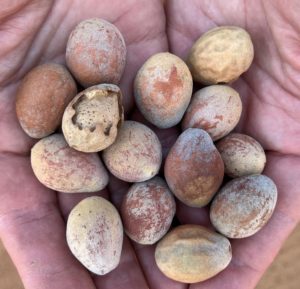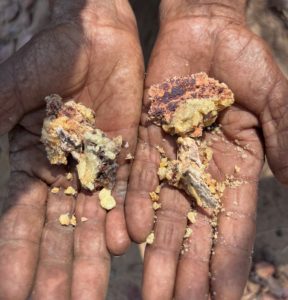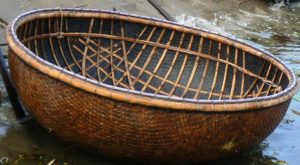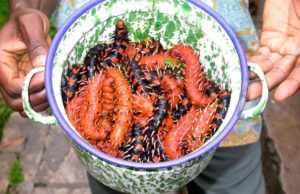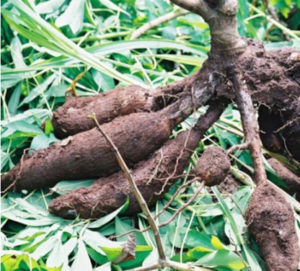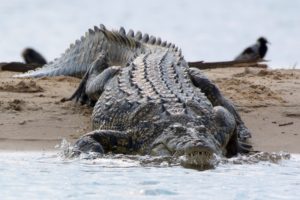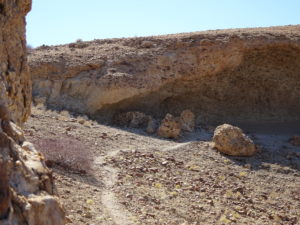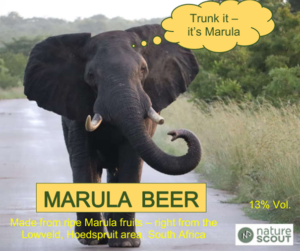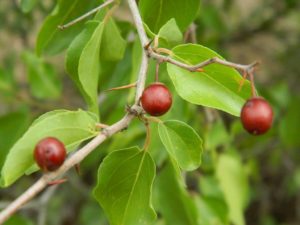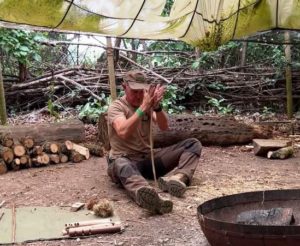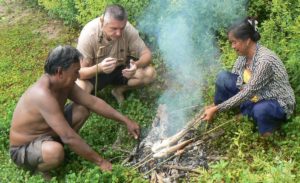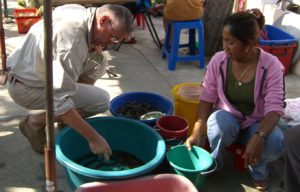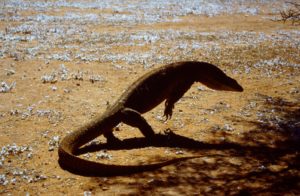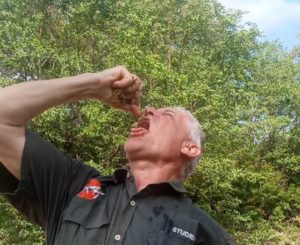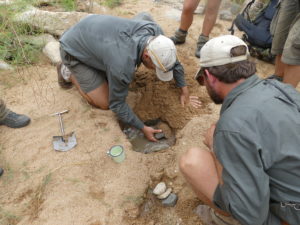Archive by publishing date
Mentawai spears
When hunting with a pack of dogs for deer, wild boars, or monkeys, three types of weapons can be used to finish off the cornered game. One is a bow and arrow, which, however, is not safe for dogs during…
How to Extract Pure Beeswax: A Simple Guide to Rendering Honeycombs
Beekeeping provides two valuable harvests: honey and beeswax. While honey is the primary product for many, beeswax is a versatile byproduct used to make candles, waterproof coatings, and medicinal salves. However, raw honeycomb is often contaminated with impurities, including bee…
Mollusks in the inland waters of Siberut Island
In rivers, coastal zones, and mangrove forests, a diverse array of bivalve and gastropod species is collected and utilized for food. Bivalvia species Freshwater streams River clams (Batissa violacea) occur in large quantities in the lower zones of all slow-flowing…
Bamboo: The Orang Asli’s natural toolkit
If rattan is the skeleton of Orang Asli junglecraft, bamboo is the toolkit. From riverbanks to misty hill slopes, clusters of bamboo mark places where people have worked, cooked, travelled, and sheltered for countless generations. To an untrained eye, most…
Soapbush – a versatile junglecraft plant
Soapbush (Miconia crenata) is also called Koster’s curse, or, due to its former scientific name (Clidemia hirta), Hairy clidemia in English. It is a highly invasive plant in tropical climates, and many countries have developed eradication programs against this weed….
Rattan: Flexible raw material from the forests
Deep in the lowland dipterocarp forests of Peninsular Malaysia, long before you see rattan, you feel it. Hooks catch on shirt sleeves, flagella tug gently at your backpack, and the forest floor is littered with the thorny sheaths of climbing…
Hand-made fishing hooks from Bali
While travelling to the northern coast of Bali/Indonesia, we met the owner of a general store at the Banyuasri Singaraja Market, whose employee was hammering fishing hooks on a makeshift anvil outside. The owner, Pak (Mr.) Gede Suarka, nicknamed “Lolak,”…
Operation of conch traplines for octopuses
In the following, we will describe the catching operation of octopuses from a fishing vessel with the help of conch traplines. This is the high-end operation of catching these cephalopods, and, based on catching weight, the primary one. But the…
Conch shells for catching Marbled octopuses
Marbled octopuses like to hide in small caves at the seafloor. Fisherfolk use this behavior and offer artificial caves, which they populate. Even while retrieving, the octopuses will not leave their shelter and can be easily caught. Since ancient times,…
Collecting honey from Dammar bees in Sri Lanka
The Rock Vedda people at Rathugala near Gal Oya in Sri Lanka collect honey from stingless Dammar bees. This last remaining band of Rock Veddas in Sri Lanka consists of 68 families, of which only ten of them still live…
Jengkol seeds
Jengkol (Archidendron jiringa) is a tropical tree that grows up to 20 meters high in the rainforests of Southeast Asia. The seeds are mainly eaten in Indonesia, but also in Malaysia, Thailand, Cambodia, and Myanmar. These seeds are called stink…
Improvised firearms of the Orang Rimba people
Improvised firearms are the new hunting weapon of choice for the wild living Orang Rimba people in Jambi province, Indonesia. In one of the following articles, I will present their traditional hunting techniques and typical hunting weapons. Here, I will…
Dangers in the Khao Sok NP in Thailand
About the Khao Sok National Park The Khao Sok National Park is located in the Surat Thani province of Thailand, and about 150 km north of Phuket in a straight line. Cheow Lan Lake on the northern park border serves…
Orang Rimba spring pole snare traps
When we were visiting a band of primitive living Orang Rimba (Kubu) people in Jambi province, Sumatra, Indonesia, each of their shelters had a spring pole snare trap nearby, which was set when they left for a walkabout. The working…
Jungle footwear for Southeast Asia, Part 3
As the topic of jungle footwear is quite an extensive one, it was split up into three articles. The first part covered general requirements, including going barefoot and wearing sandals. The second part covered shoes, including barefoot shoes, rubber shoes,…
Jungle footwear for Southeast Asia, Part 2
As the topic of jungle footwear is quite an extensive one, it was split up into three articles. The first part covered general requirements, including going barefoot and wearing sandals. This second part covers shoes, including barefoot shoes, rubber shoes,…
Jungle footwear for Southeast Asia, Part 1
In the remaining jungles of Southeast Asia, suitable footwear is of utmost importance for local people and outsiders. The rainforest environment has specific requirements that differ considerably from those of other biomes. However, the suggested footwear not only depends on…
Cooking rice in a bamboo
Bamboo is a highly versatile plant that can be used for various applications, including cooking rice in sections of its culms. Near Gerak, in Perak State, Malaysia, I met a street vendor who was traditionally cooking rice. Similar vendors can…
Bubble Green Seaweed on tropical coastlines
On many tropical seashores, green, jelly-filled bubbles can be found. They are either single bubbles or club-shaped bubbles originating from a single center point. In case they are single bubbles, it is a seaweed called Valonia ventricosa, the ‘Bubble algae’,…
Wild yam in Perak’s forests
When walking with Orang Asli people from the Jahai tribe in the forests near the Royal Belum State Park in Perak, Malaysia, they showed me their traditional favorite staple food source: wild yam tubers. These tubers can be eaten without…
Building the sidewalls of simple Jahai huts
Jahai huts, characteristic of the Semang Orang Asli people, exemplify the widespread use of bamboo as a material for floors and sidewalls. The Jahai people settle in and near the area of the Royal Belum State Park in Perak, Malaysia,…
Snake senses
It’s hard to imagine how snakes perceive the world as they slither on the ground, underground, or move through the trees and shrubs. Snakes have extraordinary senses, including perceiving the world in ways that humans cannot. Some of the senses…
Red torch ginger fruits
Red torch ginger (Etlingera elatior) fruits are commonly eaten by Jahai Orang Asli people in the forests of the northern State of Perak in Malaysia. These fruits are not only consumed by the forest dwellers of Perak State, but also…
Harvesting rattan palm hearts
When walking with Jahai Orang Asli people near the Royal Belum State Park in Perak, Malaysia, they showed me some of their plant food sources in the forests. One of them was young rattan palm shoots. For the Jahai people,…
Rattan palm fruits in Perak’s jungles
Rattan palm fruits are available from most of the 70 species of the Calamus genus in Malaysia. But also species of Daemonorps and Korthalsia rattan genera often carry edible fruits. We went with the Jahai Orang Asli people into the…
Wild ginger stalks for food
When walking with the Orang Asli people of the Jahai tribe near the Royal Belum State Park in northern Malaysia, they showed me various edible plants in the rainforest that they ate regularly. One of them was a Zingiberaceae (Ginger)…
Stilt fishing in Sri Lanka
Stilt fishing, locally known as ‘Riti Panna’, was an essential and unique fishing technique on the southern coast of Sri Lanka between World War II and the 2004 tsunami. After this period, this coast was developed into a major tourist…
Moon mushrooms at the Royal Belum State Park in Malaysia
Moon mushrooms (Gymnopus sp.) are one group of edible mushrooms found in the forests of Malaysia, and are locally called ‘Jamur bulan’. The other groups of edible mushrooms are colloquially known as wood ear mushrooms, oyster mushrooms, and shiitake mushrooms….
Fruits eaten by Mentawai people
The fruits eaten by Mentawai people in the forests are various species of bananas, coconuts, durians, and fruits from the rattan palm. Other fruits are also harvested, of which some grow wild, while others are planted and cultivated. Fruits are…
Vegetables eaten by Mentawai people
Cassava (Manihot utilissima) leaves and Fiddlehead ferns are the most essential vegetables for the Mentawai people living in the forests of Siberut Island. Both vegetables were discussed in separate articles on this webpage. Details about Cassava leaves can be found…
Freshwater fishing at Siberut Island
Depending on the location of the longhouse of a Mentawai family, fishing is conducted in any permanent water structure large enough to hold fish, gastropods, or crustaceans. In general, fishing is regarded as the work of men; women fish only…
Carbohydrate food sources of Mentawai
Three of the four most essential food plants for Mentawai people on Siberut Island in Indonesia are carbohydrate sources. Notably, sago is a key provider, with an average composition of approximately 94% carbohydrates, about 7% moisture, and negligible other components….
Snakes on Siberut Island
Bites from venomous snake species appear to be the highest concern when walking in the Siberut forests. There are anecdotal reports that middle-aged Mentawai men were bitten by pit vipers three or four times in their lives. Non-Venomous Snakes (Harmless…
Shrimp pit traps on Sri Lanka’s east coast
Fish, crabs, and shrimp provide the livelihood of small-scale and artisanal fishermen on the east coast of Sri Lanka. Due to specific local conditions, various fishing and gathering techniques have evolved, including the use of shrimp pit traps. Tidal situation…
Forest liana provides food and rubber
Description An extensive forest creeper growing from 20 – 50 m long, scrambling over trees and bushes at the forest edge. All parts exude white milky latex when cut. Bark is smooth and brown. It has brown tendrils up to…
Gathering of Venus clams by finger probing
Venus clams (Meretrix meretrix), correctly named ‘Asiatic hard clams’, are one of Thailand’s most sought-after clams for food. They occur both in the Gulf of Thailand and on the coasts of the Andaman Sea. Fully grown species are large; their…
Vedda flint & steel fire making
Village and Rock Veddas have used flint and steel to produce fires since the end of the 19th century. My former article about Vedda fire drills explains these two different Vedda types. Village Veddas have used this fire-making procedure since…
Vedda fire drills
Until the end of the 19th century, the Vedda people in Sri Lanka used fire drills as their standard fire-making method. In the literature of that time, Vedda was spelled Veddah, and Sri Lanka was called Ceylon. Current situation of…
Beach huts of Zanzibar
Traditionally, the beach huts of Zanzibar are often simple thatched structures made from coconut palm leaves, mangrove poles, and coral stone. Initially, they served as a storage place and shelter for fishermen, who needed them to repair nets, store fishing…
Feral donkey trails leading to water
At the end of the 19th and beginning of the 20th centuries, many draught animals were released in the wild in Western Australia, as motor vehicles took over their work. These included donkeys and camels. Both species flourished thereafter in…
Hadzabe footwear
Hadzabe people use footwear to protect their feet in their living areas. They need adequate foot protection against thorns, sharp plant blades, and edgy stones, as well as against the heat on sand and rock surfaces. In former times, they…
Smoked oysters from the rocks
In the spring of 2025, I traveled to Western Australia to document local survival techniques used by Indigenous people. Across Australia, Indigenous groups are generally categorized into three main types: the so-called ‘Saltwater mobs,’ who live along the coast; the…
Collecting sea urchins in the lagoons
The Collector urchins (Tripneustes gratilla) are a sea urchin species around Zanzibar. Its gonads, which contain either the roe (females) or milk (males), are a delicacy. This sea urchin species is harvested in the hot months of the year, and…
White-spotted hermit crabs
While beachcombing in the lagoons of Zanzibar, we found a White-spotted hermit crab (Dardanus megistos) housing itself in a Fusinus sp. shell. These crabs are exceptionally beautiful, and I therefore want to present them in this article. Description of White-spotted…
Black Lollyfish for food
The Black Lollyfish (Holothuria atra), the Black sea cucumber, is found primarily in the Indo-Pacific region and Zanzibar. It has a distinct cylindrical body, typically black or dark brown in color, with a smooth, leathery texture. It is commonly covered…
Wild sandfish sea cucumbers
Sandfish sea cucumbers (Holothuria scabra) are the most valued species in many tropical coastal regions, particularly Asia. This is based on their use in traditional medicine and as a delicacy. Overexploitation has led to population declines in some areas, prompting…
Freshwater springs in the lagoons
Freshwater springs in the lagoons of Zanzibar are a unique feature of this island. Although such springs exist on many – or even most – coasts worldwide, these Zanzibarian springs can be used as a characteristic example of this phenomenon….
Coastal foraging at Zanzibar
Coastal foraging and fishing are the foremost traditional activities people do on the coasts of Zanzibar. These activities are not restricted to this island or country but everywhere worldwide with a suitable coast. In English, coastal foragers are also called…
Ngalawa boats
Ngalawa boats are extended log boats with double outriggers and lateen sails used by artisanal fishers on the East African coast. They are between 4 and 9 meters long, but most of them are somewhere in the middle between these…
Spearing of African blue swimming crabs
Africanan blue swimming crabs (Portunus segnis) are speared by beachcombers in the lagoons of Zanzibar. These crabs, however, are not the prime target when spearing but only an opportunistic by-catch. The prime target when using spears for fishing is octopuses….
Conch collection for food
Humpbacked conch shells (Gibberulus gibberulus) are true conchs based on the type species Strombus gibberulus. In Swahili, they are called Chuale and are primarily collected by women, who use them for their family’s subsistence and cash income. They are harvested…
Basket fish traps at the seashores of Eastern Africa
Large basket fish traps, with a hexagonal shape and one inverted end, are typically used in Zanzibar and are called ‘Dema’ in Swahili. These fish traps, which have a large mesh size, were initially made from palm leaves and mangrove…
Fruits eaten by Hadzabe people
Besides honey, meat, Baobab fruits, and tubers, berries are one of the significant food classes that the Hadzabe people eat. Honey is the most important one for both Hadzabe males and females. However, females relish berries as the second most…
Sea hare without caviar
Sea slugs of the taxonomic family Aplysiidae are commonly called ‘sea hares’, because when underwater, their rounded body shape and the long rhinophores on their heads resemble that of a sitting rabbit or hare. Unlike other sea slugs (nudibranchs), they…
Catching octopuses in the lagoons
Catching octopuses in the lagoons of Zanzibar is an age-old and sustainable activity mainly carried out by adult women. Depending on the number of caught animals, they are used to feed the family and sold to restaurants and fishmongers. As…
Water disinfection by UV-rays from the sun
One method of disinfecting water from biological hazards is utilizing UV rays from the sun, known as SODIS (Solar Disinfection). The principle of water disinfection by solar radiation was first discovered in 1984 by Prof. Aftim Acra of the American…
Sea lettuce for salad
Sea lettuce (Ulva lactuca) is common on most shorelines worldwide. This article focuses on the island of Zanzibar in Tanzania. There, sea lettuce is used as an export article and supplementary food for humans. In addition to being collected in…
Top 10 rare snakes of Southern Africa
We often get asked what the rarest snakes in southern Africa are. This is hard to quantify, as some species may be locally abundant but in areas rarely visited. Other species may live underground and only become active above ground…
Edible red seaweed on Zanzibar beaches
In Zanzibar, two edible red seaweed species are commonly used for food: Spinosum and Cottonii, also called ‘Elkhorn sea moss.’ Both species can be found wild in the coastal area and are also farmed intensively. In addition to these two…
Bamboo rat for dinner
Bamboo rats are a common rodent in bamboo thickets in mountainous areas of northern Vietnam. Hmong tribal people in remote regions still hunt them regularly for food. Although hunting bamboo rats is officially prohibited, the practice is still widespread. To…
Creating fire with a magnifying glass
A magnifying glass has been used to start fires since ancient times. Greek and Roman writers recorded the use of ‘Burning glasses’ for domestic and war purposes. A concise history of these applications can be found on Wikipedia. Nowadays, fires…
White truffle hunting in Istria/Croatia
White truffles (Tuber magnatum) are the most highly-priced truffle species. In total, six different truffle species occur on the Istra peninsular. Four of them are variations of Black truffles (T. aestivum, T. aestivum var. uncinatum, T. melanosporum, T. brumale), and…
An oyster species growing on Mangrove trees
Mangrove oysters (Isognomon ephippium) are the species most commonly found growing on mangrove trees in Northern Australia. Its other common English name is ‘Saddle tree oyster.’ These oysters are one species eagerly collected and eaten by Bardi people at the…
Edible Rubber Vine Fruits in Central Africa
Landolphia camptoloba (Apocynaceae) Common names: Mbungumbungu, dinsania, dinsona (Kongo). Magoki is also used for all Landolphia species with edible fruit. Description A slender vine or shrub growing from 30 cm to 8 m long. Mature fruits, 5 cm in diameter,…
Edible Ferns of Papua New Guinea
Some times ferns are eaten in large quantities. At highland pig kills, ferns are one of the most common edible greens. Some ferns are only eaten with meat. Some other ferns are eaten more regularly and are very much liked….
Are snakes dangerous?
Snakes are mysterious creatures – secretive and elusive and, of course without legs, yet they can slither quickly, disappear down holes, swim effectively and climb trees. Many snakes are venomous and some highly so. Fear of snakes There are many…
The various uses of Oil palms in D.R. Congo
Elaeis guineensis (Arecaceae); Common names Ba di nsamba, ba di ngasi (Kongo), palmier à huile (Fr.), oil palm Ecology In Kongo Central scattered trees are commonly left in the bush fallow. Propagation Seed requires heat treatment before it will germinate…
Origin of Bananas
Most areas of Papua New Guinea have bananas. Some people have them as their main staple food while in other areas they are just a snack food. There is a very large amount of variation within the banana varieties in…
First Aid for Snakebite
Back in the nineteenth and twentieth century people tried various remedies to treat snakebite. This included cutting and sucking at the site of the bite, rubbing in Condy’s Crystals but the all-time favourite was a tight arterial tourniquet high up…
Long-spine Porcupinefish on the coast of Zanzibar
The Long-spine porcupinefish (Diodon holocanthus) is one of the many seafood organisms local people catch or collect at low tide in shallow waters around Zanzibar island. This fish is not specifically searched for, but it will be happily speared and…
Datoga spears
These spears have a long history but were replaced for hunting by bows and arrows in modern times. Nowadays, their primary purpose is personal protection against predators when traveling on foot for longer distances. The author encountered a couple of…
Datoga huts
The Datoga are pastoralist people living in various regions of northern Tanzania. Their estimated population is about 30,000. One of their main settlement areas is on the eastern shore of Lake Eyasi. Datoga settlement areas consistently face pressure from the…
Bow hunting equipment of the Datoga tribe
Datoga people are spread over a wide area on the Masai steppe in Northern Tanzania. Their main stronghold is around Lake Eyasi. There, especially in the Yaeda Valley, they live close to the Hadzabe people. Masais pressed Datogas into less…
Hadzabe Axes
Hadzabe axes are part of the standard outfit of every Hadzabe man living in remote areas. This outfit consists of his bow, a bunch of arrows of various types, a firestick, his knife, and the axe. Additionally, he will carry…
Hadza hand drill friction fire
Hadza hand drill friction fires are the standard fire-making method of the Hadzabe people in Tanzania, who live remotely. They do not have the omnipresent butane gas firelighters of the modern world or any other artificial methods. Even when lighting…
Hadza Arrow Poison – Strophanthus and Acokanthera species
Arrow poison based on Adenium sp. plant extracts was covered in a former article on this website. In the following, we will discuss the second type of poison the Hadzabe people make, which they call Shanjoko, a Strophanthus species. Additionally,…
Hadza Arrow Poison made from Adenium species
Remotely living Hadzabe people use three types of arrow poison to bag big game animals. However, due to the shrinkage in the size of their areas, they currently produce only two kinds. I will describe these arrow poisons briefly to…
Hadza style of shooting bows
Shooting bows by remotely living Hadza boys and men is a daily, necessary affair. From the age of three, they start shooting bent sticks. As youngsters, they are soon required to contribute meat to the family. Through this early and…
Cold-forging of iron arrowheads
The Hadza people, who live in remote areas, produce iron arrowheads themselves. Contrary to what is often mentioned in the literature, they do not buy these iron arrowheads from the Datoga people. Both tribes used different production methods. Whereas the…
Hadzabe arrow shafts and fletchings
Arrow shafts are a piece of Hadza men’s identity. Remotely living Hadza men always carry their bows, arrows, and firesticks. Whenever they have leisure time, they attend to their arrows by building new ones, checking and correcting their straightness, or…
Types of Hadzabe Arrowheads
Hadzabe people use four basic arrowhead types, which are further divided into different styles. All of these types and styles serve specific hunting applications. 1st basic type of Hadzabe arrowheads: Wooden arrow tips These types of arrowheads are called hik’o…
Hadza bows for hunting
Hadza bows are not only used for hunting but are also ubiquitous adornments for nearly all Hadza men. They even carry their bows, arrows, and firesticks around when they are not going to hunt. The bows are often short-lived and…
Hadza hunting techniques
Hadza people in remote areas of Tanzania are one of the last remaining hunter-gatherer tribes in Africa. However, only about 25% of Hadza people live this original hunter-gatherer life. That means, from a total population of about 1300 Hadzabe in…
Baobab seeds and pulp porridge
Baobab seeds and vine roots are staple foods for remotely living Hadza in Tanzania. This article already presented the collection and preparation of vine roots. In the following, we will discuss how to prepare Baobab seeds and their surrounding dry…
Sweat Bees – not a danger, but a nuisance
Correctly named Sweat Bees are Halictid Bees, an extensive and diverse family of bees. These small—to medium-sized bees are often the most common flower visitors and essential pollinators. About one-third of all bee species in East Africa are halictids. However,…
Stingless bee honey collected by Hadza people
The Hadzabe people eagerly collect stingless bee honey all year long. They do this destructively by cutting open the hives in tree hollows, and both honey and brood are harvested and eaten. Foraging on these insects has not significantly affected…
Traditional Hadza camps and huts
Traditional Hadza camps are loose affiliations of relatives, in-laws, and friends. Each camp has a few core members, but most others come and go as they please. If there are conflicts, the feuding parties will resolve them by simply separating…
Hottentotta trilineatus scorpions at Yaeda South in Tanzania
We found Hottentotta trilineatus scorpions when camping on a rocky ridge in the Yaeda South area. The place where we put up our tent was about 2 km / 1.2 miles from the next Hadza camp and in the middle…
Hadza water sources
The Hadzabe (plural of Hadza) natural environments are the escarpments and rocky, wooded hills that form the watersheds for Lake Eyasi and Yaeda Swamp in Tanzania. In this Rift Valley environment, seasonal rainfall changes and surface water availability from runoff…
Climbing a Baobab tree
A Baobab tree (Adansonia digitata) is characteristic of African Savannah biomes. In Tanzania, the Hadza people in the mountainous southern area of Lake Eyasi taught us to climb these trees. Although it is not difficult, knowing the techniques for a…
Wild Sweetpea tubers as food for Hadza people
Wild Sweetpea (Vigna frutescens) tubers are a staple source of starchy food for the Hadza people in Tanzania. The plant’s common name in the Hadza language is //ekwa. To collect them, groups of Hadza women regularly head out into the…
Orang Rimba shelters in the forests of Sumatra
Orang Rimba (locally called Kubu) shelters and dwellings in the forests are designed in different styles rooted in their semi-nomadic lifestyle. These structures can be divided into two main groups: semi-permanent structures and shelters when they are on the move….
Tu-Lip trees in Papua New Guinea
Tok Pisin: Tu lip; Scientific name: Gnetum gnemon What does a tu-lip tree look like? It is a small tree often only 8-10 metres high. It is a fairly straight tree with one trunk that has branches spread out along…
Traditional Remedies for Snakebite
A recent social media post claimed that, following a snakebite, chewing the bark of a cashew nut tree would neutralize the venom of the snake and ensure the full recovery of the victim. In many tropical African countries, cashew nut…
Visiting Orang Rimba people in Jambi province
Who are the Orang Rimba people? The expression ‘Orang Rimba’ means ‘People of the rainforest,’ but this name is primarily used by scientists internationally. In Indonesia, the people call them ‘Kubus,’ which means being outside or on the fringe of…
Collecting honey in a rock crevice
Asian honey bees and their combs are a special treat for the local population of backcountry areas at Pu Luong Nature Reserve in northern Vietnam. The harvested honey is seldom sold and is mainly used by the villagers. The grubs,…
Harvesting Shipworms in a Thai Mangrove Forest
Edible shipworms, in this case Bactronophorus thoracites, are also known as Naked clams, Priyang talay (เพรียงทะเล), and various other common names throughout the region where they occur. They bore into wood immersed in salt water and are a major hassle…
Hog plums for food
Spondias mombin (Anacardiaceae); Common names: Mungyenge (Kongo), Hog plums Description A tree which grows to 25 m. Flowering occurs during the dry season. Fruiting of hog plums starts after about 5 years though cuttings may produce earlier. The tree has…
Disinfecting water with Potassium Permanganate
Potassium permanganate is an essential chemical for various simple living applications. One is its disinfecting effects, and the other is the possibility of chemically starting fires. This article discusses disinfecting water on a small scale for drinking purposes. We will…
Small black snakes of Southern Africa
The small black snakes, which are found across Africa, are tricky to learn to identify. The danger lies in the fact that most species are harmless or mildly venomous, but can be easily confused with the venomous stiletto snakes. Many…
Collecting Pipi clams at Rawai Beach
Pipi clams (Donax deltoides) are also known as Surf clams, Sandy Donax, and a wide range of other common names. In Thailand, they can be found on most beaches in the Gulf of Thailand and the Andaman Sea. They are…
Bottom fish traps of the Urak Lawoi people
The following information was gathered from a Urak Lawoi man who has lived in the Rawai Beach Sea-Gypsy Village for 27 years. He was 57 years old and only had one tooth (incisor) left in the middle of his upper…
Rectangular squid traps in Thailand
Rectangular squid traps are used in the Gulf of Thailand and along the coastline of the Andaman Sea in the same way as semi-circular traps. Both types are used mainly for catching Bigfin reef squid (Sepioteuthis lessoniana) but will also…
Catching mud crabs at Koh Lanta
Mud crabs are common in mangrove areas in Thailand. They are primarily caught in crab pots for commercial purposes. However, my Urak Lawoi friends and I specialized in digging up and catching these crabs by hand. Who are Urak Lawoi…
Giant Fennel pith for transporting fire
While researching various bushcraft and survival topics, I constantly encounter inconsistencies and errors on reputable websites. Therefore, I have gotten into the habit of checking many postulates myself. One of these statements is that Prometheus brought fire to Earth with…
Red-tailed pipe snake
The ‘Red-tailed pipe snake’ (Cylindrophis ruffus) was recently renamed ‘Jodi’s pipe snake’ (Cylindrophis jodiae), which we are talking about here. It is called a ‘Pipe snake’ because it has a round, pipe-like body. The lower end of the body can…
Ambarella fruit in the Mekong Delta
Ambarella fruit (Spondias dulcis Parkinson; syn.: Spondias cytherea) is native to Melanesia and Polynesia and was introduced worldwide throughout the tropics. Its other common English names are Jew plum and Golden apple. In the Mekong Delta, it is omnipresent in…
Trapping eels in Northern Vietnam
Trapping eels is a simple way for rice farmers in the catchment area of the Red River in North Vietnam to provide themselves with animal protein. No special skills are required, as with angling or net fishing. The activity is…
Advanced Rifle Handling (ARH) for Trail Guides
Hikes through natural areas in Southern Africa where dangerous game is present must be conducted with at least one, but usually two, armed trail guides. One is the “Lead Guide” or “1st Rifle,” and the second is called the “Back-up…
Bow Drilling – following the method of Mattias Norberg
At the Global Bushcraft Symposium 2022 in Wales/UK, the Swede Mattias Norberg demonstrated his method of creating fire by bow drilling. Sweden has a rich outdoor tradition, and it was a privilege to meet him there, as he has deep…
Giant Fennel stalks for lighting fire
Various internet pages and YouTube channels describe lighting fire with stalks of giant fennel (Ferula communis) as easy. I doubted these claims, so I tested them myself. The outcome was sobering, which I will describe in the following article. I…
Vine snakes of Africa
Vine Snakes (previously called Twig or Bird Snakes) are widespread across Africa and are usually found in warm savannas and forested areas. There are currently four species and one subspecies of Vine Snake in Africa. The status and distinguishing features…
Giant Fennel stalk wood as building material
Giant Fennel (Ferula communis) is a common weed in Mediterranean countries and Central Asia. Except for one genetic variety in Sardina, all green parts of the plant are strongly haemotoxic and lead to the poisoning of livestock and humans. This…
Edible rock snails in limestone areas of Vietnam
Rock snails of the genus Cyclophorus are highly sought-after wild foods in rocky limestone mountain areas of Vietnam. These snails are not only regarded as food but also as medicine against various ailments. The local Vietnamese name is Ốc thuốc,…
Blowpipe hunting with Orang Asli people in Malaysia
Blowpipe hunting is still prevalent in many Orang Asli communities in Malaysia. Although the government strictly enforces hunting rules and regulations, it is practically impossible to supervise all the remote small hamlets and villages. On the other hand, it is…
Collecting Bibi worms on Koh Lanta
Bibi worms (Sipunculus nudus Linnaeus, 1776) belong to the Peanut worm phylum. They can be dug up at the intertidal zone of flat, sandy beaches on temperate and tropical beaches. These worms are primarily used as top fishing bait. At…
Wild asparagus in Sicily
Wild asparagus, a unique culinary delight, is prominent in Sicily’s springtime cuisine. The region boasts two distinct species: Asparagus albus, White asparagus, and Asparagus acutifolius, affectionately dubbed ‘Wild asparagus’ in English. Another edible part of these plants is its ‘crown’…
Stone huts at Mount Etna in Sicily
Stone huts on the northern side of Mount Etna in Sicily were built at least since pre-Hellenic times, around 4,000 BC. The building materials were basalt blocks from eroded lava at this location. The builders used dry-stone wall construction without…
Ginger flowers add zest to food
Ginger flowers are eaten in many Southeast-Asian cultures. In Indonesia, most ginger varieties are known from Siberut Island. The native population of this island has utilized the flowers of Torch Ginger (Etlingera elatior (Jack) R.M. Sm.) since ancient times for…
Young Cassava Leaves provide protein and micronutrients
Young cassava leaves are a regularly eaten side dish for Mentawai people. Cassava (Manihot esculenta, Crantz) is endemic to the southern rim of Amazonia in South America. There, it was domesticated around 5000 BC. In the 16th century AC, Spanish…
Vegetable ferns are a source of nutrients in Siberut
Vegetable ferns (Diplazium esculentum (Retz.)) are among the few wild vegetables Mentawai people in the forests eat regularly on Siberut Island. By Mentawais, they are called ‘Laipat.’ Other wild vegetables are cassava leaves, ginger flowers, taro stalks, and wild eggplants….
Scissor Traps of Thái Đen tribals in Vietnam
Scissor traps are universal traps that can catch all kinds of small rodents. They are easy to produce from bamboo but need one item to be sourced in the villages. These are strips of bicycle tubes, which are not easy…
Bow Traps of Thái Đen tribals in Vietnam
Bow traps are used by Black Thai tribal people in Northern Vietnam to catch small rodents. These ingenious devices are carved from pieces of bamboo and some strings. The closing force of the scissor comes from a bow-like structure above…
Domestic pigs as food by Mentawais
Domestic pigs are a typical gift from a Mentawai family to a shaman for his support or services. In our case, Aman Aru attended a ceremony in a neighboring Uma (family home in the forests), which had to be cleaned…
Deadfall Traps of Thái Đen tribals in Vietnam
Deadfall traps with a Figure-4 trigger are essential knowledge for survivalists and bushcrafters worldwide. Thái Đen (Black Thai) tribal people at Pù Luông Nature Reserve in Northern Vietnam use these traps and the Figure-4 trigger in a modified version. Modifications…
Mentawai forest huts
The Mentawai people at Siberut Island use forest huts (called Sapou by them) for various reasons and purposes. One is a permanent dwelling for single, old men who do not live with their family in the Uma (family home in…
Rattan fruits in Siberut jungles
Rattan fruits are available throughout the year in all Southeast Asian rainforests. There are about 600 different species of rattans, and many of them bear edible fruits. However, rattan prickles are a common nuisance when walking in the jungle. Nevertheless,…
Giant snakes
Seeing movies like Anaconda let many people believe that there are monster snakes in jungles, some even exceeding 10 m in length. However, those stories have been doing the rounds for many years. So much so that the New York…
Carrying baskets of Mentawai people
Mentawai people use five types of carrying baskets, which they call Opa, Tuku, Jarakjak, O’orek, and Bolokbok. Opa – the standard-sized carrying baskets. Opa are the most popular type of carrying baskets. They are entirely woven from Calamus javensis rattan vines collected from…
Cutting- and chopping tools at Siberut Island
The cutting- and chopping tools used by forest dwellers include adzes, axes, machetes, and a specialized knife. All of these tools have a strong historical background and are still in use today. Axes People primarily use axes (Oggut) to fell…
Sago worms of an unidentified species at Siberut Island
Sago worms are one of the food items that come naturally with the Mentawai’s staple food, sago flour. The worms grow in felled palm trunks or saplings. They are not worms but larvae and pupae of the Palm Weevil beetles…
Mentawai Shamanic Rituals: The Role of Sacrificial Chicken in Siberut Culture
Deep in the rainforests of Siberut Island, the Mentawai tribe food culture transcends simple nutrition, weaving a complex web between the physical world and the spirit realm. While their diet is traditionally rooted in sago and forest foraging, the domestic…
The Use of Rattan Leaf Stalks as Coconut Graters in Mentawai Culture
Rattan leaf stalks have been, since immortal times, the tools with which Mentawai people have been grating coconuts. These long-lasting tools grate the coconuts into the required size of flakes. When worn out or broken, a new one will be…
Taro – another staple food of the Mentawai people
Taro (Colocasia esculenta (L.) Schott) is one of the three staple food items of the Mentawai people on Siberut Island in Indonesia. The other two are sago and bananas. In many other countries, taro leaves and corms are eaten. Mentawais…
Roasted Sago sticks on Siberut Island
Roasted sago starch is the staple food for Mentawai people living in the moist, tropical forests of Siberut Island, off the coast of Western Sumatra in Indonesia. On the other hand, sago, boiled to porridge, is eaten as a staple…
White Ginger Lily for cleaning hands
White Ginger Lily (Hedychium coronarium J. Koenig) belongs to the Zingiberaceae (Ginger) botanical family. Mentawai people use the crushed stem to clean their hands after touching arrow poison or one of its two poisonous main constituents. In another article on…
Danger of Asian elephants – whether they are in musth or not
Asian elephants (Elaphas maximus) are smaller than their African cousins but not less dangerous when in musth. That danger was already described for African elephants in this article on this website. In the following, we briefly compare the differences between…
Mentawai arrow poison
The Mentawai people use poison on their arrows to hunt game. In previous articles on this website, we discussed the Mentawai people’s hunting methods. Then, we presented an actual hunt for Flying foxes. We then discussed the longbows used on…
Hunting arrows and quivers of the Mentawai people
Bows and arrows are the primary hunting weapons used by the Mentawai people. Their bows were already described here. This article will explain the different types of arrows used for these bows and give an insight into the quivers used….
Mangrove apples at the Mekong Delta
Mangrove apples are the fruits of Sonneratia sp. trees, one of the important genera of trees in the Mangrove forests of Southeast Asia. All species of Sonneratia will develop edible Mangrove apples. The various Sonneratia species differ slightly in shape,…
Animal species collected by rice farmers in the Red River Delta
Rice farmers in secluded areas of the Red River Delta in Northern Vietnam need dietary additions to their staple rice dishes. Vegetables are harvested from around their homes and surrounding tropical Evergreen forests. Animal proteins are mainly collected in and…
Natural shampoo from a Soap plant (Gouania leptostachya)
Natural shampoo can be extracted from a variety of plants worldwide. In the evergreen forests of Lowland in Northern Vietnam, we used the leaves of a so-called soap plant. With these leaves, we regularly washed our hands and bodies. In…
Egg carton fire starters
Fire starters are convenient aids in Austria’s cold winters. Wood shavings lighted wood- and coal-burning stoves one generation ago. These shavings lighted spruce kindling, which in turn started burning bigger pieces of wood. Nowadays, it’s easier. Either commercially available or…
Building a specialized fishing boat at Padang
In Indonesia, there is a wide variety of traditional fishing boat designs. Most of them are variations of standard types adapted to local needs and conditions, and many of them have not been systematically described yet. This article presents one…
Stinging Nettle Slug Caterpillar in Vietnam
When hiking in Pu Luong Nature Reserve in northern Vietnam, we found a species of Stinging Nettle Slug Caterpillar on a Banana leaf. My local friends got highly nervous when they saw it, and I was intensely warned against touching…
Boiling water in bamboo
Boiling water in green bamboo stems (‘culms’ would be the botanically correct term) is not a significant skill, but it represents the basic cooking technique in Southeast Asian forests. One of the following articles will build on that and explain…
Trapping Snakeskin Gourami in the Mekong Delta
Trapping Snakeskin Gourami fish (Trichopodus pectoralis) is commonly done all over Southeast Asia. However, a specific trap for catching them was developed in the Mekong Delta in Vietnam. Its simple principle could be easily applied to many other areas of…
Green-billed Malkoha bird on the spit
The Green-billed Malkoha is a common bird in Vietnam’s semi-deciduous tropical forests. An expedition led to the capture of one who was cooked for lunch. This and other species are often hunted by villagers supplementing their diet with this and…
Catching Octopuses by Sea-Gypsies
Sea-Gypsies – Urak Lawoi, Moklen, and Moken – traditionally catch octopuses along the Andaman Sea’s rocky shores, which they call โวยวาย in the Thai language. Using a metal skewer and baited bamboo stick, they locate octopuses in holes with foam…
Mentawai Hunting bows
Hunting bows are the primary hunting weapon for the Mentawai people and are very personal items for a hunter. They have excellent skills in using them and practice shooting from childhood onwards. During my stay with the Mentawais, I looked…
Flying fox hunting
Flying fox hunting remains a prevalent activity in Indonesia, particularly in Sumatra. Aceh, the northernmost province, is the epicenter of the trade in Flying fox meat. Locals believe that this meat possesses qualities to alleviate asthma, although this claim lacks…
Hunting methods of Mentawai people
The hunting methods of the Mentawai people have developed over about 3000 years. Their ancestors were of a Mongolian race that migrated from Taiwan via the Philippines to modern-day Indonesia. They arrived around 1000 BC at Siberut island in West…
Holiday time and snakes
As the holiday season starts, many people will be returning to their family homes or are off on vacation. Snake season is in full swing with decent temperatures and sporadic rain. We are currently seeing a number of snake bites…
What is Fongaar? The Tropical Tuber That’s Part Sweet Potato, Part Yam.
Scientific name: Ipomoea macrantha Roemer & Schultes; Synonyms: Ipomoea tuba (Schlechtend.) G. Don; Plant family: Convolvulaceae; Tok ples: Fongaar What is the plant like? The plant has a long angular vine 5 to 6 metres long and it climbs up…
How Mentawai people assemble roof thatching panels
Roof thatching is vital for shelter waterproofing in the Mentawai tribe, which has around 6,000 members, on Siberut Island, Indonesia. Siberut lies about 100 miles (160 km) west of Padang in West Sumatra. Of the 6,000 Mentawai people, roughly 1,000,…
Raphia sese – a very special Raphia palm
Raphia sese (Arecaceae) Common names: Nsaku (Kongo = knife with a long blade), ba di magangu (Kongo). Description A palm which grows in dense clumps up to 10 m tall. Female flowers are produced at the base and male flowers…
Mambas of Africa
“Muhle wena kona hamba,skati wena bona mamba,noko wena hayi tshetsha,wena ifa lapa stretsha.” African proverb “It’s advisable to hamba (walker),when you stumble on a mamba,for if you do not tshetsha (move),you’ll expire on a stretcher.” Mambas have a bad reputation…
Pitpit – Edible grasses in Papua New Guinea
Three types of pitpit grow in Papua New Guinea: Coastal pitpit The pitpit plant looks like sugarcane to which it is related. Normally the stalk is thinner than sugarcane. It can grow up to 3 metres high and produces suckers…
Batwa pygmies traditional fire lighting method
The Batwa people live around Bwindi Mgahinga National Park in Uganda. This park is significant because it houses half the world’s mountain gorilla population. The Batwa were the last tribe permitted to hunt in this national park before they were…
African milkbush causes painful blistering and inflammation
Euphorbia tirucalli (Euphorbiaceae) Common names: Ngego, ngewu, nlembonlembo (nlembo = finger) (Kongo), Euphorbe effilée, tirucalli (Fr), finger tree, finger euphorbia, African milkbush Description A leafless succulent shrub with cylindrical shoots, 2 – 8 m tall. All parts produce copious white…
Some varieties of edible wild mushrooms in DR Congo
Some mushroom collectors And some sellers Bunsambi (Polyporus tenuiculus) grows on dead tree trunks (particularly Voacanga africana) and can be found throughout the year. It is cooked with simsim or seeds of pumpkin or squash. Lumvumvu (Lentinus squarrosulus) Grows on…
Wild Karuka and another pandanus fruit species
The Pandanaceae botanical family comprises the following six species in Papua New Guinea: ‘Karuka’ and ‘Marita’ were already discussed on this website in two former articles. ‘Karuka’, see here, and ‘Marita’ see there. In the following, ‘Wild Karuka’ and Pandanus…
Some important edible caterpillar species in Kongo Central, Part 2
In former articles on this website, we already discussed two edible caterpillar species from Kongo Central. One species was ‘Bisu’ Nudaurelia petiveri, which was described here. And the other species was ‘Kaba’ Lobobunaea phaedusa, described in this article there. Additionally,…
Snake Teeth and Fangs
Most snakes have quite long, thin, sharp, and recurved teeth for catching and eating prey. These teeth are firmly anchored to the anterior bone on the lower jaw and the upper jawbone. Just like sharks and crocodiles, snakes replace their…
Karuka – cultivated pandanus fruits and nuts
Tok Pisin: Karuka Scientific name: Pandanus jiulianettii Two species of pandanus are commonly used for the nuts that are eaten. They are Karuka (Pandanus jiulianettii Martelli) and wild Karuka (Pandanus brosimos Merr & Perry). At least 3 other species of…
Some important edible caterpillar species in Kongo Central, Part 1
In former articles on this website, two edible caterpillar species from Kongo Central were already discussed. One species was ‘Bisu’ Nudaurelia petiveri, which was described here. And the other species was ‘Kaba’ Lobobunaea phaedusa, described at this article there. In…
About snake home ranges and territories
We are often asked whether snakes have a specific territory. The word territory is perhaps not the correct term as it infers that snakes would protect this area to keep other snakes out of it. Snakes do not live in…
Catching Ghost crabs by digging
Ghost crabs (genus Ocypode) comprise 22 different species, and they are commonly also called `Sand crabs.` The scientific name Ocypode has Greek origin and means swift-footed. Ghost crabs are semi-terrestrial crabs that dig deep burrows in intertidal zones of sand. They…
Giant Taro – a plant with a giant root
English: Giant taro; Scientific name: Alocasia macrorrhiza (L.) Schott; Synonyms: Alocasia indica (Lour.) Spach; Plant family: Araceae Description of Giant Taro plants A very large herb of the taro family. It has a stout erect trunk up to 4 m…
Snake Season in Southern Africa
Spring (Sept/Oct in the Southern Hemisphere) is snake season and as the temperature rises, snakes leave their underground shelters in search of food. It is a slow process and they become more active as the temperature increases. Once the first…
Three-spot swimming crabs on surf-beaten sandy beaches
Description of the crab species Three-spot swimming crabs (Ovalipes trimaculatus) have a rounded triangular carapace with five legs on either side. The tips of the back pair of legs are flattened into paddles for better maneuvering in the water. Adorned…
Swiss pine cones and their uses
The Swiss pine (Pinus cembra) goes by different names in German-speaking countries, such as ‘Zirbe,’ ‘Arve,’ ‘Arolla pine,’ or ‘Austrian stone pine.’ For generations, people have used the nuts of this particular pine species as food during the winter months,…
Why Bushmeat Snaring is the Silent Killer of the African Bush
Bushmeat snaring is a widespread hunting method in Sub-Saharan Africa. Public landscapes in this part of the world are often devoid of larger wild animals due to bushmeat hunting. This is so bad in some places that mammals – even…
The Green Mamba
The Green Mamba (Dendroaspis angusticeps) was described by Sir Andrew Smith in 1849 from animals collected from Natal. Taxonomy The Latin name angusticeps comes from “angustus” meaning narrow and “ceps” an abbreviation for head – narrow head. Surprisingly, many years…
Elephant diggings in dry riverbeds
African elephants (Loxodonta africana) require approximately 40 to 60 gallons (150 to 220 liters) of water daily to maintain their health. They obtain this water from various sources, including open water bodies and wells dug in sandy riverbeds. Additionally, elephants…
Use of Tsamma melons in Namibia
Tsamma melons are the original progenitors of watermelons. Historical records indicate that these melons were already under cultivation in the Nile Valley as far back as 2000 BC. In contemporary times, Tsamma melons continue to be utilized for their oil…
Preventing Snakebite in Southern Africa
Snakebite was recently recognized as a neglected tropical disease by the World Health Organization with about 20,000 snakebite fatalities reported every year in Africa. Subsequent morbidity affects far more people than that. In South Africa we have around 4 000…
Neolithic fishhooks in Korea
During the Neolithic Age (8000 BCE—1400 BCE), people across various regions began to adapt to the evolving natural environment following the Ice Age. This era is characterized by the emergence of earthenware artifacts and groundstone tools and the establishment of…
Marita – a lesser known pandanus fruit
English names: Marita or ‘Red Fruit’ Tok pisin name: Marita Bahasa Indonesia name: Buah Merah Scientific name: Pandanus conoideus Lamarck The marita pandanus plant A short much branched screw pine with many prop roots. The prop roots have prickles. Trees…
Seekoraal plants in Southern Africa
Seekoraal is the Afrikaans term for the Salicornia natalensis plant, which belonged to the Sacocornia taxonomic genus before being reclassified under the Salicornia genus in 2017. Salicornia plants are succulent, halophytic (salt-tolerant) flowering plants in the Amaranthaceae family. They thrive…
Yam varieties in Papua New Guinea
Four species of yam are commonly grown and used for food in Papua New Guinea – but often naming in villages and naming by scientists do not agree. Many village people regard potato yam and 5-leaflet yam as varieties of…
Solomon’s Sago – another Sago palm species
How is this sago different? The Solomon’s sago palm that occurs in the North Solomon province and the Solomon Islands is quite different from the sago that grows in other areas of Papua New Guinea. It has a different scientific…
Sago – staple food in parts of Papua New Guinea
There are two Sago palm species in Papua New Guinea. Metroxylon sagu Rottb. and the other one occurs in North Solomons Province and the Solomon Islands. Its scientific name is Metroxylon salomonense. The sago palm plant The sago palm grows…
Utilizing Horseshoe Crabs as a Food Source
Foreword Horseshoe crabs are a species not protected in Thailand and are experiencing a significant decline. Their primary habitats, particularly the mudflats around mangrove forests, where they live and reproduce, are diminishing, and there is a growing demand for edible…
Using a stomping basket to catch fish in Vietnam
Fishing with a stomping basket has been a traditional craft in Vietnam for centuries. Postcards from the French colonial era depict this unique fishing method as a typical way for locals to catch fish. While similar techniques exist in other…
Giant Snakehead fishing in Thailand
The Giant Snakehead fish (Channa micropeltes) is a highly aggressive and predatory freshwater fish. Its diet mainly consists of smaller fish, frogs, crustaceans, and aquatic prey. In Malaysia, Singapore, and Indonesia, this fish is known as the ‘Toman’ and, along…
Shore fishing for Bronze Whaler Shark
Bronze Whaler Sharks (Carcharhinus brachyurus), also known as Copper Sharks, are sought-after game fish for recreational anglers in many parts of the world. They are known for their impressive strength and fighting abilities, which challenge anglers. These sharks can reach…
Catching Tigerfish at the Zambezi
Tigerfish hold a similar significance for Africans as the bass for Americans or carp for Europeans. These three fish species effectively represent the human populations on their respective continents. Tigers are my favorite, as they possess a remarkable blend of…
Making bow strings from plant fibers
The manufacture of bow strings from plant materials is a skill that Bushmen have practiced for a relatively short period. Around 1900, they learned from neighboring Bantu-speaking tribes how to use Sansevieria fibers to create bow strings. Before this, they…
Sweet ‘White Berry Bush’ fruits
Synonyms White Berry bush, Snowball bush (Eng.); Witbessiesbos (Afrikaans); Chinese waterberry (China), Goowal (Yawuru Australia); Flueggea virosa (Lat.) – Flügge was a German botanist, and virosa means poisonous or having a bad odor. Distribution Flueggea virosa commonly grows in deciduous…
Mahout training at Lampang province
The National Elephant Institute of the Forest Industry Organization of Thailand conducted mahout training for amateurs near Lampang. This institute was initially established as a training center for elephants working in the timber industry, where they learned how to lift,…
Composition of Bushmen Arrows
The topic of the composition of Khoi-san (Bushmen) arrows for hunting is vast and intricate. Numerous anthropological studies have documented the unique designs utilized by nearly every family group of Khoi-san in Southern Africa. These designs are often a result…
Making bushmen bows for hunting
Generally speaking, the Khoi-san (‘Bushmen’) employ bows and poisoned arrows for “tracking and stalking” during hunting in Northern Namibia and North-Western Botswana. The various Khoi-san tribes utilize different materials and techniques for crafting these weapons. However, in this article, we…
Eating centipedes in Yunnan Province, China
Eating insects and centipedes is a long tradition in Lijiang City, in Yunnan Province, P.R. China. In addition to centipedes, other insects such as bamboo worms, silkworm pupae, and locusts are also consumed. While they are high in protein and…
Bushmen hunting techniques in Namibia
In earlier times, the Ju//hoansi Khoi-san (Bushmen) of North-East Namibia employed four distinct traditional techniques for hunting animals. These techniques have remained unchanged, as even today (in 2023), the Ju//hoansi continue to eschew the use of firearms, sticking to their…
Sourplum fruits for food and oil
Sourplums, which belong to the Olacacea family, comprise two species: the Blue Sourplum (Ximenia americana) and the Great Sourplum (Ximenia caffra). Blue Sourplum The Blue Sourplum is naturally distributed in semi-tropical and tropical countries worldwide, as shown on the map….
Beachcombing for Vongole clams in Northern Italy
Vongole clams (Ruditapes philippinarum) are the main bivalve species collected from the flat beaches of the Adriatic Sea in Northern Italy. Introduced to aquaculture facilities in the lagoon of Venice in 1983, they are now considered an invasive species, having…
How to find freshwater on sandy beaches?
Freshwater seepages occur along drainage lines on beaches, where the water table meets the sea. These seepages are fed by freshwater supplies from inland, and the land beyond the sea is naturally higher than sea level, causing freshwater to flow…
Semi-Dried Fish in Thailand
In Thailand, both sea and freshwater fish are dried to increase their shelf life for later human consumption. Before the advent of refrigeration, the primary method for preventing spoilage was to salt the fish and then leave it in the…
Using Honey Locust Pods as Food
The Honey locust tree, also known as the Thorny locust, derives its genus name (Gleditsia) from a former director of the Botanical Garden in Berlin. Its species name (G. triacanthos) means ‘Three thorns’, which refers to the typical arrangement of…
Limpets on rocky shorelines
Limpets (Scutellastra sp. and others) have conical, oval-shaped shells that range from 1-10cm in diameter depending on the type of limpet. Their shell is ribbed or smooth depending on the limpet species. The shells are normally brown, grey, or black…
Canh Măng Mực: The Royal Dried Squid and Bamboo Soup of Bát Tràng
Experience the sophisticated flavors of Northern Vietnam with Canh Măng Mực, a rare, traditional Vietnamese squid-and-bamboo soup. Deeply rooted in the culinary heritage of the ancient Bát Tràng ceramic village near Hanoi, this dish is far more than a simple…
Description of a speargun for freshwater fishing
In the following, we will briefly describe a specific speargun for freshwater fishing, which I bought from a fisherman in the northern suburbs of Bangkok, Thailand. It is neither as primitive as many of these guns are, nor is it…
Mechanically propelled darts for freshwater fishing
Mechanically propelled darts for freshwater fishing are commonly used all over Thailand. Many craft these devices themselves, so there is a wide variety of principles, styles, and designs. Besides homemade spearguns, where every piece is unique, industrial manufacturing is also…
Weaver ants got interesting traits
Weaver ants of the genus Oecophylla consist of two different species. One species is Oecophylla longinoda, which occurs in equatorial, tropical African regions. The other species is Oecophylla smaragdina, distributed in tropical Asia and Australia. Both of them are also…
Sansevieria leaves and their uses
Sansevieria and its leaves were a genus of flowering plants originating in Africa and southern Asia. This former genus comprises approximately 70 species, commonly known by English names such as mother-in-law’s tongue, bow string hemp, snake plant, and snake tongue….
Water dispensers for handwashing
In the former Soviet Union- and its satellite states, many citizens had and have water dispensers in their so-called ‘Dachas’ (Russian: дачи). Dachas are typically simple, free-standing houses located in city suburbs or the countryside. And most of them do…
Chacma Baboons – a dangerous nuisance
Baboons are one of the largest-sized Old-World monkeys. Due to hybridization, their taxonomy is contested and overlapping. In Africa there are six species of baboons, and in Southern Africa lives one species, which is Chacma baboons (Papio ursinus). Chacma baboons…
Nara melons: Bread of the Namib desert
Nara melons were, in former times, the only food Topnaar people had available for four months (Jan – April) a year. They used conserved fruit pulp and seeds to supplement other food sources for the rest of the year. They…
Camelthorn as firewood
Camelthorn is an excellent firewood in Southern Africa. Its outer layer is light-colored sapwood, and its dark, hard, and heavy heartwood is inside. This hardwood produces long-lasting coals and high heat. Its northernmost distribution area extends from the Northern Cape…
Grey Foam-nest Tree Frogs
Grey foam-nest Tree Frogs (Chiromantis xerampelina) are called ‘Southern Foam-nest Tree Frogs’ or ‘Foam-nest Frogs’. Their native distribution range is Southern- and Eastern Africa, in various habitats. Minimum habitat requirements are temporary pools of water with trees overhanging branches. The…
Australian Firesaws
Firesaws are only known as a traditional fire-making method on the Pacific Islands. In Australia, these methods were replaced by friction fire hand drills and later, under Western influences, by bow drills. Nevertheless, fire sawing is an interesting technique, which…
Ghost Mantises are impressive insects
Ghost praying mantises (Phyllocrania paradoxa) fit perfectly into our new homepage section called ‘Wonders of Nature’ due to their unique appearance and behavior. They are a species of praying mantis, and four characteristics make them unique. These are an impressive…
Himba smoke shower
The Himba women continue practicing traditional personal hygiene methods, including using a smoke shower and a mixture of red ochre and butter-fat paste. These Indigenous people are properly referred to as the ‘OvaHimba’ when plural and are mainly semi-nomadic, residing…
Knobkerries at a Museum in Hluhluwe
Knobkerries are straight, wooden clubs with a knob on one end. Together with assegais (throwing spears), they are the symbols of various African nations. These two weapons are part of the South African Coat of Arms, introduced in April 2000….
Koppie Foam Grasshoppers
Koppie Foam Grasshoppers (Dictyophorus spumans) are indigenous to South Africa and prefer sparse and low vegetation on rocky outcrops. They are flightless and have some aposematic coloring, which are yellow or orange stripes on the warty thorax shield and stripes…
Determining cardinal points by trees
Determining cardinal points by trees in Southern African savannas (Southern Hemisphere) is a standard procedure. It is helpful in case one is lost, and the sun cannot be seen. At least one can determine where the cardinal points are. Cardinal…
Mopane worms – high protein food in Africa
Mopane worms (Instars of Gonimbrasia belina) are mainly found on Mopane trees (Colophosperma mopane) but also on Wild Syringa (Burkea africana), Zebrawood (Microberlinia Brazzavillensis) and others. However, Mopane trees are a highly dominant species in climates and areas suitable for…
Milkplum (Stamvrug) fruits grow directly out of the tree trunk
Milkplum (Englerophytum magalismontanum (Sond.) T.D.Penn). Common names: (Afr) Stamvrug. (Eng) Milkplum, Wild plum. (isiZulu) Amanumbela. (Northern Sotho) Mohlatswa. (siSwati) UmNumbela. (Tshivenda) Munombelo. (Xitsonga) Nombhela. Old name: Bequaertiodendron magalismontanum Distribution Milkplum is widely distributed from Central Africa to Botswana and Eastern…
Termite soil as building material
Termite mounds are primarily made of soil, excavated below the mound, and carried to the surface by these insects. They use the soil to construct the mound, forming it into various shapes depending on the termite species. The exterior of…
How to Determine Wind Direction in the Savannah: A Practical Guide
In the open landscape of the savannah, pinpointing wind direction is essential for navigation, tracking, and staying undetected by wildlife. Follow these key methods to read the air: Why Wind Direction Matters in the Savannah Determining wind direction is necessary…
Safari toilet at Timbavati tented bush camp
A safari toilet is essential for any temporary tented camp in the wild. For a Trails Guide course at Timbavati Private Nature Reserve in South Africa, we had eight students, two mentors, and one cook, a total of seven tents…
Salt intake at seashore survival activities
The salt intake of a human in case of an actual survival situation or when living from the provisions of a shoreline by purpose is of utmost importance to its health. If too much salt is consumed, the body has…
Parabuthus scorpions at Erongo province
Parabuthus scorpions are commonplace in Erongo province in Namibia. The area has unique geology, including red sandstone formations and granite mountains. It has a rugged, arid landscape with rocky outcroppings, mountains, and canyons. This area is home to several species…
Traditional fishing at Inle lake in Myanmar
Traditional fishing at Inle Lake is endemic and specific to this local environment. Inle Lake is the second largest lake in Myanmar, approximately 50 square miles (abt. 116 km2). During the dry season, the average water depth is only 7…
The Evolution of Fire
The history of fire is fundamentally the history of humanity itself. Long before our ancestors learned to create a flame, fire was a terrifying natural force—a byproduct of lightning strikes that brought both destruction and opportunity. However, the transition from…
Monkey orange, an eagerly sought-after fruit
Monkey orange is the collective common name for the fruit of at least five different Strychnos tree species, which occur from Durban/South Africa up to Western Tigray in Ethiopia. These fruits are highly delicious, and all parts of the trees…
Game trails towards water in African savannas
Larger herbivores in African savannas formed game trails by regular use over eons of years and many, many generations. These trails connect water sources and feeding and bedding areas within their home range. And for a few of them, they…
The Lip Test: A Secret Russian Taiga Method to Check Firewood
If you are outdoors in boreal forest biomes worldwide, protecting yourself against wind and wetness is paramount. And to light a fire for warmth. The necessary firewood should be dry to burn hotter and with less smoke. But if you…
Chewing sticks for dental care in Southern Africa
Chewing sticks, or toothbrush sticks, were widely used in former times from Ethiopia down to the southern tip of Africa. Nowadays, plastic toothbrushes are commonly used, and chewing sticks are still commonplace only in very rural parts of this area….
Purple Laver – cherished food in many cultures
Purple Laver (Porphyra capensis) belongs to a genus of cold-water seaweeds that grow in shallow seawater. More specifically, it belongs to the red algae phylum of laver species (from which comes laverbread), comprising approximately 70 species. It grows in the…
Field dressing and cooking a puff adder
Puff adders (Bitis arietans) are widely distributed throughout Sub-Saharan Africa, except in dense rainforest areas and Madagascar. They have a tell-tale flat head with a straight line between the eyes, a thick body with chevron markings, and a stumpy tail,…
Bluebottle jellyfish – a stingy creature
The bluebottle jellyfish, also known as Physalia utriculus, is commonly found along the coasts of non-tropical regions bordering the Atlantic, Indian, and Pacific oceans. These creatures are not jellyfish but rather siphonophores composed of multiple organisms known as zooids. These…
Finding direction with Buffalo weaver nests
The Red-billed buffalo weaver (Bubalornis niger) is a common bird in parts of Southern Africa. These birds have the largest body size of all weavers and are common in dry woodland and savannas. Buffalo weavers have a peculiar trait when…
African termite alates for food
In Southern Africa, Harvester termite alates (Hodotermes spp.) and Mound-building termite alates (Macrotermes spp.) swarm within a specific area usually once a year. These alates are winged termites, which termite workers keep within certain chambers in the mound. They represent…
Black mussels at the Namibian coastline
Black mussels in Namibia include the following species: Ribbed mussel (Aulacomya atra), Black mussel (Choromytilus meridionalis), Mediterranean mussel (Mytilus galloprovincialis), Brown mussel (Perna perna) and Bisexual mussel (Semimytilus algosus). In one of my former articles on this website, I discussed…
Beekeeping Safety in the Bush: Improvised Veils, Suits, and Smokers
Locally made-up smokers and overalls are used for inspection or harvesting the hives as improvised equipment. These have also become expensive and are often shared by a group of beekeepers. Improvised protective overalls A protective bee suit enables the beekeeper…
Low-Cost Beekeeping: How to Build Alternative Beehives in D.R. Congo
In recent years the shortage and expense of timber and corrugated iron sheet have encouraged people to use alternative materials for beehives. The range of substitutes includes old 200-liter fuel drums cut in half. Their ends removed, and their sides…
Beekeeping in Congo, Central province
Honey hunting has been a traditional activity in Bas-Congo, as in much of Africa. But beekeeping in Congo has only been practiced in the area since the early 1980’s. The beehive in common use is the top bar hive which…
Skinning and processing of dormice in Slovenia
Before dormice can be skinned, processed, and cooked – they have to be caught. That is an art of its own and is described in an article under this Link here. Skinning and processing of dormice is done similarly to…
Manketti wood for friction fire lighting
In the northeastern parts of Namibia, Ju//hoansi Khoi-san bushmen preferably use Manketti wood (Schinziophyton rautanenii) for friction fire lighting, at least in areas where Manketti trees are growing. Such areas have slightly higher elevations compared to savanna bushveld vegetation. Both…
‘Bush potatoes’ from Cowpea plants in Namibia
Cowpeas (Vigna lobatifolia) are strong climbers that resemble Mung beans. The stem of this vine is up to 6 m long and develops trifoliate leaves. Its flowers resemble purplish pea-flowers, and the pods are about. 7 – 9 cm (2…
Safari footwear for hiking in African savannas
Proper safari footwear is essential for hiking in Southern African savannas. These savannas are defined by a lush grassy layer and a notable woody layer consisting of trees and shrubs, but neither dominates the biome. Depending on particular climatic conditions…
White mussels at the Namibian coastline
Description of White mussels White mussels (Donax serra) are wedge-shaped bivalves with coarse ridges across the posterior. The inner surface is smooth and has a purple tinge. It has a short, stubby inhalant and a long, thin exhalant siphon. It…
Dormouse trapping in southern Slovenia
Worldwide, the dormouse family consists of three sub-families and 29 species and in Slovenia the ‘European edible dormouse’ (Glis glis) is native. There live three other dormouse species: garden dormouse (Eliomys quercinus), forest dormouse (Dryomys nitedula), and hazel dormouse (Muscardinus…
Manketti (or: Mongongo) nuts
Manketti nuts are a staple food for a variety of people within its distribution range. And there is a strict division of naming them. Khoi-san people (Bushmen) call them ‘Manketti’, whereas Kavango people (Bantus) call them ‘Mongongo’. Both names denominate…
Wild Syringa (Burkea africana) edible tree resin
Many African trees extrude edible gums and resin. Notable Vachellia ssp. and Senegalia ssp. (old name: Acacias) are known for their edible gums. Khoi-sani people collect and eat whatever edible gums and resins they find on the go. In our…
Leaf huts as temporary shelters for shade
Members of the Khoi-san (Bushmen) tribe named Ju//hoansi are also called !Kung. Both the signs / and ! denote click sounds. The tribe is about 30,000 people spread over Namibia, Botswana, and southern Angola, with a central area at the…
Beer can hut near Spitzkoppe in Namibia
Empty aluminum beer- and pop cans will serve additional purposes after guzzling the content. Besides toys and various repair applications, these cans can build huts and houses! As can be seen in Texas, the US here, or Australia there, which…
Throwing sticks as weapons in the African bush
Kerries combine throwing sticks and wooden clubs as everyday tools for hunting, defense, and digging in Southern Africa. Australian aboriginals used a refined form of throwing sticks, flattened over its whole length and called ‘Kylie’ by them. Eventually, boomerangs evolved…
Bamboo shoot harvesting at the Red River
With more than 70 bamboo species throughout the country, we can easily find bamboo thickets anywhere in Vietnam. Many could nurture one of the most popular and favored vegetarian foods for Vietnamese people, bamboo shoot harvesting. Two main types of…
Growing Artocarpus altilis (Breadfruit) in Central Africa
Synonyms A. communis, A. incises; Common names Kikwa ki santu Petelo (Kongo), arbre à pain (Fr.), breadfruit Description A tree up to 35m tall produces a wide crown. All parts of the tree produce a white, bitter latex. Fruits are…
Green caterpillars, called ‘Kaba’ in D.R. Congo
The name Kaba is used for several large green caterpillars. Lobobunaea phaedusa can be up to 10 cm long and is usually found singly between October and May. When disturbed the caterpillar contracts in defence. They are sometimes very difficult…
Coracles at Duy Hải, near Hoi An, Vietnam
Hoi An is located about 35 km south of Da Nang, which is roughly in the middle of mainland Vietnam. It is one of Vietnam’s most picturesque towns and attracts many tourists. Which in turn requires lots of fish and…
Bush Yams in Western- and Central Africa
Synonym: D. cayenensis var. praehensilis; Common names: Kisadi, sadi, Bisadi (Kongo), Igname de brousse (Fr.), bush yams, forest yam Description A sturdy climbing plant, up to 15 m long, growing from a large tuber that often protrudes from the ground….
Edible caterpillars Nudaurelia petiveri
This species (Nudaurelia petiveri) is widespread throughout western, central, and southeastern Africa. It appears in Kongo Central in December and January. Up to 200 eggs are laid in clusters on the undersides of young leaves. They hatch after about two…
Indochina Dragon Plums from Hanoi streets
The Indochina Dragon Plum (Dracontomelon duperreanum) is a genus of flowering plants in the family Anacardiaceae. In Vietnamese, it is called chi sấu). Dragon Plums are one of the most popular trees on the side of Hanoi streets. The fruits…
Collection of edible caterpillars in D.R. Congo
Children are the main caterpillar collectors, though most people while walking in the bush, keep a constant watch for them. Frequently people will bring back young caterpillars and place them on trees near their homes where they can keep an…
Traditional processing of cassava in Congo
Image sequence of cassava’s long way from root to market and shows the processing of cassava in its various steps Source This article is an excerpt of Paul Latham’s and Augustin Konda ku Mbuta’s books ‘Useful plants of Kongo Central…
Edible Caterpillars for food in Congo
Rural families in Kongo Central find it very difficult to get sufficient protein to eat. Hunting has cleared out most of the larger animals and even many of the smaller animals, such as the cane rat, are now difficult to…
Rattan vine in Africa – Calamus deerratus
Synonym C. laurentii; Common names Nkau (Kongo), Rotin (Fr.), Rattan vine Description A slender to moderately robust rattan palm, climbing up to 20 m high and often forming dense clumps. The stems and leaves are armed with spines. Stems have…
Cassava, a staple food in Central Africa
Synonym: M. utilissima; Common names: Dyoko, Saka Saka (Kongo), Manioc (Fr.), Cassava roots Description A perennial shrub, up to 3 m high, with enlarged tuberous roots and a well-developed root system. There are many varieties, some of which are bitter…
Tetracera alnifolia – a vine for water shortages
Tetracera alnifolia (Dilleniaceae); Synonym T. alnifolia subsp. alnifolia; Common names Kiziazi, Nziazi, Nziazia (Kongo), Liane à eau (Fr.), Water tree Description A woody creeper up to 20 m long and up to 10 cm. in diameter. Leaves are 4 -…
Edible caterpillars in D.R. Congo – an introduction
My first experience with edible caterpillars took place in 1985 when my wife and I lived at Kavwaya near Kisantu in what was then the Bas-Congo province of D.R. Congo. On one occasion I was shown how to hunt for…
African mammee apple in West- and Central Africa
Common names are Mafambu, Dimbu dingi (dingi = gum, resin, incense) (Kongo), Bokodji (Lingala), African mammee apple, Oboto or Djimbo (commerce). Scientific name: Mammea africana. Description A large forest tree up to 45 m tall with a straight, cylindrical trunk…
Okra plants in D.R. Congo
Okra plants (Abelmoschus esculentus): Synonym: Hibiscus esculentus Common names Dongo, Lonto (Kongo), Dongo dongo, Molenda (Lingala), Gombo (Fr.) Description An erect annual herb usually 1 – 2 m. high. Leaves are 3 to 5 lobed, spirally arranged and may be…
Pla Ra – Thailand’s fermented fish condiment
Pla Ra (Thai: ปลาร้า, pronounced [plāː ráː]), is fermented fish. Traditionally, Thais in the Central and Northeast provinces (Isan) eat fish and rice. In these relatively poor provinces, there is only one rice growing cycle every year. The planting season…
Spotted hyenas are successful hunters
Spotted hyenas (Crocuta crocuta) occur throughout sub-Saharan Africa. Exceptions are Central and West African rainforests, Southern grassland biomes, and further beyond the south. The density of a hyena population in a suitable habitat depends significantly on the density of the…
Spotted beauties: Leopards in Southern Africa
Leopards (Panthera pardus) have a wide distribution range in Sub-Saharan Africa, which, however, becomes increasingly fragmented due to human activities and habitation. In the Southern African region, within the Republic of South Africa, only about 20% of the land area…
Why are hippos dangerous on land?
Hippopotami of the species Hippopotamus amphibius (‘Hippos’) are widely distributed over Sub-Saharan African savannah biomes. They were declared a ‘vulnerable’ species, as over the last ten years, the population declined between 7% and 20%. In total, there were about 130,000…
Marang fruits in Southeast-Asian Rainforests
There are several local names for the tree and fruits of Artocarpus odoratissimus. In English, it is simply called ‘Marang’, which is based on the Philippines’ common name for this fruit. Originally endemic to the region around Mindanao, Sarawak, Kalimantan,…
Drying meat in Shanghai at wintertime
It is at least a 2000-year-old tradition in many provinces in China to cure and preserve meat in wintertime. Pigs were slaughtered after the ‘Light Snowfall’ date (around Nov 22nd/23rd). Then, the temperatures plummeted, and this meat had to be…
Termite mounds indicating direction North
In Southern Africa, fungus-growing termites, which build enclosed mounds without visible ventilation holes, belong to the genera macrotermes. These macrotermes mounds can be up to 6 meters high above ground. The tip nearly always leans slightly over, and the termite…
Danger posed by Nile crocodiles
In the following, Nile crocodiles (Crocodylus niloticus) are called just crocodiles or ‘crocs’. They occur in Southern- and Eastern African regions and along the Atlantic coastline in Central Africa. They eat any animal they can get a hold of and…
Fish ripping in Hanoi, Vietnam
A typical fishing technique in Vietnam is ripping a weighted hook with multiple side arms through still water and hoping to hook unsuspecting fish somewhere on their body. Hooking a fish at the lips with the correct size and style…
Fish trapping at a fast-flowing brook in Vietnam
Trapping fish in bamboo traps in Southeast Asia is normally a static affair. These fishing traps are used in still waters with or without bait inside and checked at least once daily. It was a new experience to see somebody…
Cashew apples and -nuts in Goa, India
Cashew trees (Anacardium occidentale) are native to areas around Northeastern Brazil. Portuguese colonists brought them around 1560 to Goa, India, from where they spread to Southeast Asia and Africa. Therefore, cashew products already have a long history in Goa and…
Jujube trees at Ayutthaya in Thailand
The Ayutthaya Historical Park covers the ruins of the old city, which was founded by the Khmer in 850 AD and named after the Hindu holy city of Ajodhya. The city was destroyed by the Burmese in 1767 and has…
Cormorant fishing at Li Jiang River in China
Cormorant fishing is an ancient art that dates back at least 1300 years. Today, it is only practiced in the southwestern provinces of China. However, some fishermen are attempting to revive this fishing technique for tourists in water villages around…
Chanterelle mushrooms in Thailand
Thai chanterelles, specifically Cantharellus minor, live in symbiosis with Gurjun trees (Dipterocarpus tuberculatus) in semi-deciduous Southeast-Asian forests. These trees are easily identified due to their double-winged (di-ptero) fruits with big seeds. Besides Cantharellus minor, other species of chanterelle mushrooms are…
First shelter of Henno Martin at Kuiseb Canyon
Two German geologists, Dr. Henno Martin and Dr. Herman Korn, went into hiding around the Kuiseb Canyon area, Namibia, for 2.5 years at the beginning of WW2 in 1940 to avoid internment by the South African Union government. During that…
Trunk it – it’s Marula beer!
Marula season in Southern Africa typically occurs in February of each year. When Marulas (Sclerocarya birrea) get ripe, they turn from green to yellow and fall from the female Marula trees. On the ground, they ripen fully and will start…
Taste of Gaur meat at Kaeng Krachan rainforest
We were on a weeklong trail through the Kaeng Krachan rainforest, near Hua Hin in Thailand, when we tasted Gaur meat. Together with two National Park (NP) rangers, we came across a freshly died Gaur heifer. This Gaur (Bos gaurus)…
Natal Mahogany seed milk and its preparation
Natal Mahogany (Trichilia emetica) trees have got a dense canopy of dark green, glossy leaves, and a round outer shape of the tree silhouette. They preferably grow in moist places and riparian forests along drainage lines. Natal Mahogany is easy…
Buffalo thorn tree – an icon in Southern Africa
The Buffalo thorn tree (Ziziphus mucronata) is called in Afrikaans “Blinkblaar-wag-‘n-bietjie” for its shiny leaves and two thorns, which hold people back when getting caught by them. The shrub or tree has got distinctive zigzag branchlets with pairs of two…
Rumen fluid as an emergency drinking liquid
Rumen fluid is a greenish-colored liquid substance with an aromatic and slightly sour smell. It is uniformly distributed in the rumen of antelopes and mixed with grazing or browsing roughage, fermentation gases, and bioactive organisms. The rumen liquid primarily comprises…
Fire lighting with Flint & Steel
In the Stone Age and Bronze Age, European men created fire by striking flintstone on marcasite and catching sparks on tinder made from horseshoe fungi. Marcasite is crystallized pyrite (an iron sulfate mineral) and is not readily available but has…
Hand drilling in UK as taught by Dave Watson
Friction fire hand drills are usually not the first choice for fire lighting in the Northern Hemisphere, as they are regarded as a strenuous technique, especially in cold and humid environments. Dave Watson proved this perception is incorrect under overcast…
Bow drill standard procedure by Dave Watson
The approach to friction fire lighting with bow drills in the UK slightly differs from that in other countries. In the following, these differences will be explained. Materials and shapes of the various bow drill elements Hearth board of the…
Bow drilling in Australia by Gordon Dedman
At the Global Bushcraft Symposium 2022 in the UK, Gordon Dedman presented the bow drilling technique he teaches in Australia. Since readers are assumed to know the basics of bow drill friction fire lighting, I will only concentrate on specific…
Hand drill friction fire lighting in Australia
At the Global Bushcraft Symposium 2022 in the UK, Gordon Dedman presented the hand drill friction fire lighting method he teaches in Australia. As most readers of this topic will know the basic techniques of hand drill friction fire lighting,…
Australian friction-fire woods
At the Global Bushcraft Symposium 2022 in the UK, Gordon Dedman presented a variety of types of Australian friction-fire wood, which are well suited for friction-fire lighting methods and tinder. The signature friction-fire method, exclusively used for thousands of years…
Finding True South in the Southern Hemisphere
The Southern Cross, or the Constellation of Crux – as the name implies – is visible in the Southern Hemisphere. It consists of the Southern Cross and the two pointers: Alpha-(Rigil Kent) and Beta-Centauri (Hadar). Finding direction in True South…
Finding direction with the Pole Star
Finding the Pole Star with the Constellation of Ursa Major Only in the Northern Hemisphere is the Pole Star visible, and its location is mainly indicated by the position of the two pointers of the Great Bear (also called the…
Constellation Scorpius at the Southern sky
The Constellation of Scorpius (‘Scorpio’) is a vast constellation visible from May to November in the evening sky of the Southern Hemisphere. It is located directly opposite the Constellation of Orion – therefore, visible when Orion is not. Finding direction…
Firewood from Red Bushwillows is excellent
In Southern Africa, fourteen species of Bushwillows belong to the Combretum family. Other trees of the same Combretum family are Clusterleaf species, Leadwood, and others. Interestingly, not all Combretum species are suitable for firewood, but some are excellent for that…
The Torchwood Tree: Ethnobotanical Uses and Properties of Balanites maughamii
The Greenthorn, or Balanites maughamii, is a medium to large deciduous tree indigenous to the low-lying, sandy areas of Southern Africa. Often referred to as the Torchwood, this species is characterized by a distinctly fluted, buttressed trunk and bifurcated (Y-shaped)…
Double-banded Sandgrouse as water indicator
The Double-banded Sandgrouse (Pterocles bicinctus) is commonly and colloquially called by its abbreviation ‘DBSG’ in Southern Africa. Its main distribution area is the savanna biome, especially Mopani Bushveld. There are three more species of sandgrouses in Southern Africa, all having…
Finding direction with the Constellation of Orion
The Constellation of Orion, or ‘The Hunter’ can be best viewed in the evening skies from November to February. It holds for both the Northern and Southern hemispheres during that time. Of the three belt stars, the highest one is…
Pla Yang: Traditional Thai Open-Fire Spit Roasted Fish Guide
Grill spit for small fish outdoor cooking on a spit Smaller fish up to about 20 cm long are typically put on a grill spit, which is just a split stick. Often, in Thailand, this will be Pla Kod (Thai:…
Freshwater snails for food
In Thailand, two types of freshwater snails are commonly consumed. The first group is comprised of the larger Apple snails (Pomacea canaliculata), while the other group is referred to as Freshwater snails (Sinotaia sp. & Filopaludina sp.). These genera can…
Jellyfish for food and its preparation
Edible jellyfish (Aurelia sp.) is called ‘Maeng krapun jarn’ (Gulf of Siam) or ‘Lodchong’ (Andaman Sea) in Thailand. Usually, there are about three months a year when jellyfish appear for food. During this jellyfish run, sea fishermen earn a sizeable…
Semi-circular squid traps in Thailand
Squid is a main source of income for many fishermen in villages around the Gulf of Thailand and the Andaman Sea. Because fish are becoming increasingly rare, whereas Cephalopods maintain their population. Only certain types of finfish are sold profitably,…
Catching and holding live eels
The Asian swamp eel (Monopterus albus), called Pla Lai in Thailand, is used as a food source and for offering to the spirit deities. When still slim and young, eels are sold to the Buddhist local population for doing a…
Crab snare at Koh Samui
Simple crab snare for use on a tropical beach A crab snare is usually shaped like a bait cage with about six snares around it. This set-up combines a fishing line and rod or just hung down the sea bottom…
The Ultimate Survival Snack: Foraging and Preparing Ricefield Shrimp
Freshwater prawns, specifically Macrobrachium lanchesteri—locally known as Goong foi in Thailand—are one of the most efficient “survival foods” you can find in the wild. While they might be small, these translucent crustaceans are abundant in nearly every permanent water body…
Hand lifting net (Yor lek) in Thailand
Small lift net for catching daily meals of freshwater prawns and fish ‘Yor lek’ is a hand-lifting net; in Thai, it means something like a ‘small lift net. ‘ ‘Yor’ means ‘lift net’ and ‘lek’ means ‘small’. Its big brothers…
Cast net throwing technique
Description of cast nets used in Thailand Cast nets in Thailand are available in different radius models. I prefer one with a radius of 3.5 meters, which is from the center of the net to the outer axial rim chain,…
Small catfish got dangerous spines in Thailand
There is a variety of small catfish species with dangerous spines living in Thai waters. One, a very abundant one, is locally called Pla Kod (Hemibagrus wyckioides); English common name: Asian Redtail Catfish; Thai name: ปลากด. The typical length for…
Circumferencing water plants to catch fish
Most Thai water channels, khlongs, and streams are clogged with a variety of water plants, predominantly Common Water Hyacinth (Eichhornia crassipes). This invasive species was introduced in 1901 by Thai Royalty from Indonesia and was supposed to be eradicated by…
Crafting a bamboo fish trap in Thailand
Learning the craft of bamboo fish trap weaving The correct English wording for a ‘Lop’ in Thai would be ‘Horizontal cylinder trap with entry cone’. It is used to catch various freshwater fish and crustaceans, including small snakeheads, catfish, shrimp,…
Bank line fishing in Southeast Asia
The term ‘Bank line’ used in English to refer to a string of poles along a water bank is virtually unknown in Southeast Asia. Instead, this fishing method and its equipment are referred to by different names in the region….
Razor clams collection with quicklime
A mudflat full of razor clams ‘Don Hoi Lot’ is a mudflat in the Thai Province of Samut Songkhram with a size of about 15 km2 (about 9 square miles). ‘Don’ means ‘mudflat’ in English. ‘Hoi’ means ‘clam’, and ‘Hoi…
Harvesting and opening Nipa Palm fruits
Nipa palms (Nypa fruticans) are a species of palms especially adapted to muddy environments of slow-moving tidal waters and mangrove forests. They occur in Asia-Pacific tropical climates. Nipa palm fruits are delicious to eat. Both the fruits and wooden parts…
Mudskippers for food
In Thailand, four mudskipper species can be found. These are the Giant mudskipper (Periophthalmodon schlosseri), Blue-spotted mudskipper (Boleophthalmus boddarti), Gold-spotted mudskipper (Periophthalmus chrysospilos) and the Indian Dwarf mudskipper (Periophthalmus novemradiatus). The Giant- and Blue-spotted mudskippers live at the Andaman Sea-…
Morning glory – a valuable wild vegetable in Asia
Swamp morning glory or Water spinach (Ipomoea aquatica) has various common names, like ‘Kangkong’ in Southeast Asia or ‘Kung Shin Tsai’ in China. It is a staple vegetable food throughout the Asia-Pacific region. It is deficient in calories (19 cal/100…
Heavenly Durian
The fruit Durian (Durio zibethinus) is named after the Malay word ‘Duri’ for ‘Thorn’, referring to the thorny skin, and ‘zibethinus’ obviously refers to its smell. And the most sought-after variety in Malaysia is ‘Musang King’, where ‘Musang’ means ‘Palm…
Bamboo fence fish traps around Tonlé Sap lake
In many areas of the biggest Cambodian lake, its tributary river, and the Mekong flood plains, permanent bamboo fence fish traps, or, more appropriately, catching structures, are erected and operated. The leader fence, which guides fish into the trap’s inner…
Spear shafts from grass tree stalks
Grass trees (Xanthorrhoea sp.) and grass tree stalks are endemic to Australia. They are locally called ‘Black Boys’ due to their appearance after bushfires. They need a certain number of regular fires for their survival and are well protected against…
Spinifex grass – friend and foe
The common name ‘Spinifex grass’ is not entirely correct as a botanical term for discussed grasses, as commonly named ‘Spinifex’ grasses belong to the genus ‘Triodia’, whereas the genus ‘Spinifex’ itself contains mainly coastal grasses. Whatever it is, the common…
Spotting a magnificent sand monitor (Goanna)
Description of Goannas The Australian sand monitor (Varanus gouldii) is also called Gould’s monitor or colloquially ‘Goanna’. There are two subspecies: Varanus gouldii gouldii and Varanus gouldii flavirufus (smaller subspecies). V. gouldii gouldii is distributed nearly all over Australia except…
Eating a sand monitor lizard (Goanna)
In the former article, I described seeing a majestic sand monitor lizard close by on my drive from Menzies to Sandstone on a side road. Driving further on, I was surprised to see many more Goannas left and right on…
Ant beds for building materials in Australia
Although they are commonly referred to as “Ant beds,” particularly in Australia, the structures are actually “Termite mound.” Despite their physical similarities to ants, termites are related to cockroaches rather than ants. However, like ants, they are small and numerous….
African buffalos are dangerous
Danger of buffaloes is overrated. The ‘Cape buffalo’ (Syncerus caffer caffer) as a subspecies of the ‘African buffalo’ (Syncerus caffer) is the typical Southern African savannah biome buffalo species. The denomination of ‘African Black Death’ was coined by trophy hunters,…
Lion behavior – so different by day and night
The general behavior of lions African Lions (Panthera leo) are sometimes overrated in their danger for people hiking in Big-5 game areas. Lion behavior is such that they usually sleep and rest for 20 hours a day to replenish their…
Recipe for disaster – elephant bulls in musth
Musth is a condition of elevated testosterone levels in the blood of elephants. African elephant (Loxodonta africana) bulls come into their first musth when they are between 15 – 17 years old. The length of the musth depends on the…
Spekboom leaves as vegetable in South Africa
Among the many edible South African plants, few are as remarkable as Spekboom (Portulacaria afra), a member of the Didiereaceae family. Known locally as the elephant bush, this hardy succulent is celebrated for its ecological benefits and, increasingly, for its…
Poisonous beauty: The ‘Elegant Grasshopper’
Aposematic coloration The ‘Elegant Grasshopper’ (Zonocerus elegans) occurs commonly throughout Southern Africa and is mentioned due to its aposematic coloration, typical for animals that want to announce that they are poisonous. And he is a poisonous grasshopper. In the case…
Water from elephant dung
Elephants are a kind of dung-producing machines In the wild, African elephants (Loxodonta africana) are foraging about 150 – 180 kg of plant material per day. And they also drink about 350 liters of water. Consequently, they excrete about 10 –…
The Dark Side of Tradition: Why Modern Bushcrafters Should Avoid Native Snaring Techniques
The world of bushcraft often leans toward a romanticized view of indigenous skills, treating “native” methods as the pinnacle of sustainable living. However, there is a stark difference between survival and conservation. Nowhere is this divide more apparent than in…
Digging for water by wells in sandy riverbeds
Where to dig One of the most essential techniques for finding drinkable water in Southern African natural environments is digging for water in areas that are holding water underground. These water-holding structures can be situated next to an open water…
Creating fire by hand drill in Namibia
The type of wood for fire hand drills changed over time Fire starting with friction hand drills was traditionally common among Khoi-san (Ju//hoansi) people in their distribution area, which was once over Southern Africa and became increasingly confined by invading…
A Guide to Focusing Sun Rays for Fire Lighting
Harnessing the power of sun rays for fire lighting is one of the most elegant and rewarding skills in the bushcraft repertoire. Unlike friction-based methods that require intense physical exertion, solar ignition harnesses the sun’s virtually unlimited energy to create…



